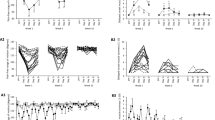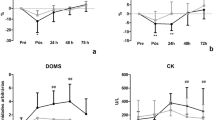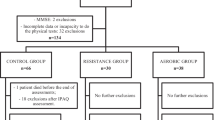Abstract
Ageing is associated with an increased susceptibility to muscle damage but little is known on how this affects muscle recovery after exercise. Hence, this study is aiming at investigating the effects of a heavy-resistance training session of neuromuscular recovery of the calf muscles of a group of elderly men aged >65. Maximal isometric and isokinetic torque, muscle voluntary activation (VA) capacity, surface electromyographic activity (EMG), peak-to-peak amplitude of action potentials associated with twitch responses of plantar flexors were evaluated before and 5 min (post1), 24 h (post2) and 48 h (post3) after 10 sets of 10 repetitions of a calf raise exercise performed at an intensity of 70% of the individual, one repetition maximum. Blood samples were taken before and 1, 48, 96 and 144 h after the training session and assayed for serum creatine kinase (CK), lactate dehydrogenase (LDH) and myoglobin (Mb). Peak torque during eccentric and concentric (120° s−1) contractions and twitch parameters were significantly reduced at post1, and recovered completely at post2. No significant changes were found in integrated EMG, M-wave amplitudes and VA throughout the entire test period. CK and LDH concentrations reached peak values 48 h after the exercise session and returned to the pre-exercise values 96 h after the training session. Serum Mb level increased by 73.2% 1 h after exercise and recovered at 48 h. The reduction in peak torque following a strength training session in an elderly population could be explained mainly by fatigue of peripheral origin. After 24 h the elders recovered completely their capacities of strength production, despite muscle damage being still evident 48 h after the strength training session.


Similar content being viewed by others

References
Allman BL, Rice CL (2001) Incomplete recovery of voluntary isometric force after fatigue is not affected by old age. Muscle Nerve 24:1156–1167
Behm DG, St-Pierre DMM (1997) Effects of fatigue duration and muscle type on voluntary and evoked contractile properties. J Appl Physiol 82:1654–1661
Béliveau L, Van Hoecke J, Garapon-Bar C, Gaillard E, Herry JP, Atlan G, Bouissou P (1992) Myoelectrical and metabolic changes in muscle fatigue. Int J Sports Med 13(Suppl):S153–S155
Bilodeau M, Henderson TK, Nolta BE, Pursley PJ, Sandfort GL (2001) Effect of aging on fatigue characteristics of elbow flexor muscles during sustained submaximal contraction. J Appl Physiol 91:2654–2664
Byrnes WC, Clarkson PM, White JS, Hsieh SS, Frykman PN, Maughan RJ (1985) Delayed onset muscle soreness following repeated bouts of downhill running. J Appl Physiol 59:710–715
Clarkson PM (1997) Eccentric exercise and muscle damage. Int J Sports Med 18:S314–S317
Clarkson PM, Nosaka K, Braun B (1992) Muscle function after exercise-induced muscle damage and rapid adaptation. Med Sci Sports Exerc 24:512–520
Dedrick ME, Clarkson PM (1990) The effects of eccentric exercise on motor performance in young and older women. Eur J Appl Physiol Occup Physiol 60:183–186
De Luca A, Mambrini M, Conte Camerino D (1990) Changes in membrane ionic conductances and excitability characteristics of rat skeletal muscle during aging. Pflugers Arch 415:642–644
Friden J, Lieber RL (1998) Segmental muscle fiber lesions after repetitive eccentric contractions. Cell Tissue Res 293:165–171
Hakkinen K (1995) Neuromuscular fatigue and recovery in women at different ages during heavy resistance loading. Electromyogr Clin Neurophysiol 35:403–413
Hicks AL, McCartney N (1996) Gender differences in isometric contractile properties and fatiguability in elderly human muscle. Can J Appl Physiol 21:441–454
Lexell J (1995) Human aging, muscle mass, and fiber type composition. J Gerontol A Biol Sci Med Sci 50 (Spec No):11–16
Manfredi TG, Fielding RA, O’Reilly KP, Meredith CN, Lee HY, Evans WJ (1991) Plasma creatine kinase activity and exercise-induced muscle damage in older men. Med Sci Sports Exerc 23:1028–1034
McArdle F, Spiers S, Aldemir H, Vasilaki A, Beaver A, Iwanejko L, McArdle A, Jackson MJ (2004a) Preconditioning of skeletal muscle against contraction-induced damage: the role of adaptations to oxidants. J Physiol 561:233–244
McArdle A, Dillmann WH, Mestril R, Faulkner JA, Jackson MJ (2004b) Overexpression of HSP70 in mouse skeletal muscle protects against muscle damage and age related muscle dysfunction. FASEB J 18:355–357
McBride TA, Gorin FA, Carlsen RC (1995) Prolonged recovery and reduced adaptation in aged rat muscle following eccentric exercise. Mech Ageing Dev 83:185–200
McHugh MP, Tyler TF, Greenberg SC, Gleim GW (2002) Differences in activation patterns between eccentric and concentric quadriceps contractions. J Sports Sci 20:83–91
Merton PA (1954) Voluntary strength and fatigue. J Physiol Lond 123:553–564
Michaut A, Pousson M, Millet G, Belleville J, Van Hoecke J (2003) Maximal voluntary eccentric, isometric and concentric torque following a concentric isokinetic exercise. Int J Sports Med 24:51–56
Morton RH, Carter MR (1992) Elevated serum enzyme activity: an explanation-based model. J Appl Physiol 73:2192–2200
Raastad T, Hallen J (2000) Recovery of skeletal muscle contractility after high- and moderate-intensity strength exercise. Eur J Appl Physiol 82:206–214
Roth SM, Martel GF, Ivey FM, Lemmer JT, Metter EJ, Hurley BF, Rogers MA (2000) High-volume, heavy-resistance strength training and muscle damage in young and older women. J Appl Physiol 88:1112–1118
Salmons S (1997) Muscle damage. Oxford University Press, Oxford
Stauber WT, Smith CA (1998) Cellular responses in exertion-induced skeletal muscle injury. Mol Cell Biochem 179:189–196
Szasz G, Gruber W, Bernt E (1976) Creatine Kinase in serum: 1. Determination of optimum reaction conditions. Clin Chem 22:650–656
Uji Y, Okabe H, Sugiuchi H, Sekine S (1992) Measurement of serum myoglobin by a turbidimetric latex agglutination method. J Clin Lab Anal 6:7–11
Wacker WEC et al (1956) Metalloenzymes and myocardial infarction II Malic and lactic dehydrogenase activities and zinc concentrations in serum. New England J Med 225:449–454
Westerblad H, Allen DG, Lannergren J (2002) Muscle fatigue: lactic acid or inorganic phosphate the major cause? News Physiol Sci 17:17–21
Winter DA, Fuglevand AJ, Archer SE (1994) Crosstalk in surface electromyography: theoretical and practical estimates. J Electromyogr Kinesiol 4:15–26
Acknowledgements
The authors are particularly grateful to the Maugeri Foundation of Pavia (Italy), for allowing access to the CSAM Laboratory where the experiments were performed, and to Dr Paolo Capodaglio for the medical screening of the participants and his support to the study. We thank TECHNOGYM Italia, for supply of state-of-the-art training apparatus and EC Contract QLRT-2001-00323 (“Better-Ageing”) for financial support. Furthermore, we are very much indebted to the senior citizens of Pavia who volunteered to take part in this study.
Author information
Authors and Affiliations
Corresponding author
Rights and permissions
About this article
Cite this article
Ferri, A., Narici, M., Grassi, B. et al. Neuromuscular recovery after a strength training session in elderly people. Eur J Appl Physiol 97, 272–279 (2006). https://doi.org/10.1007/s00421-006-0168-y
Accepted:
Published:
Issue Date:
DOI: https://doi.org/10.1007/s00421-006-0168-y



